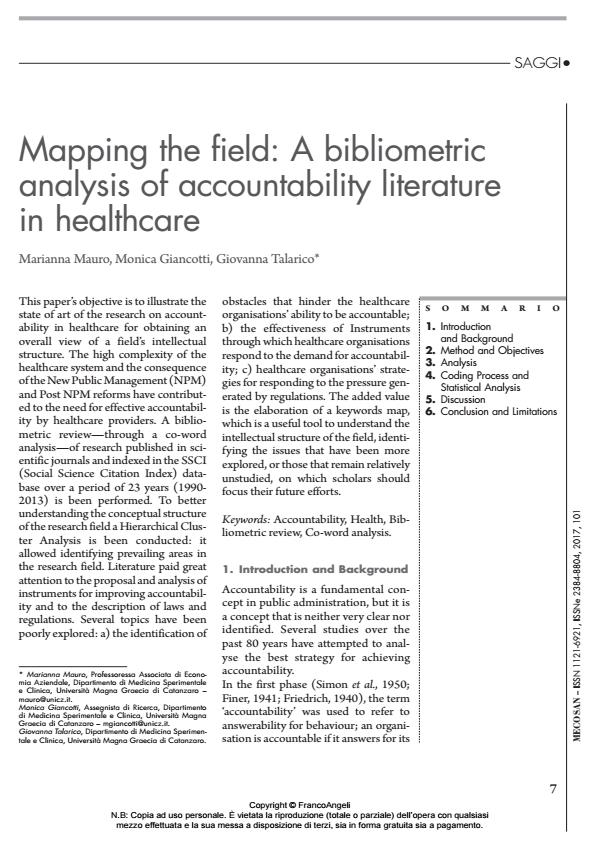Mapping the field: A bibliometric analysis of accountability literature in healthcare
Titolo Rivista MECOSAN
Autori/Curatori Marianna Mauro, Monica Giancotti, Giovanna Talarico
Anno di pubblicazione 2017 Fascicolo 2017/101
Lingua Inglese Numero pagine 24 P. 7-30 Dimensione file 23831 KB
DOI 10.3280/MESA2017-101002
Il DOI è il codice a barre della proprietà intellettuale: per saperne di più
clicca qui
Qui sotto puoi vedere in anteprima la prima pagina di questo articolo.
Se questo articolo ti interessa, lo puoi acquistare (e scaricare in formato pdf) seguendo le facili indicazioni per acquistare il download credit. Acquista Download Credits per scaricare questo Articolo in formato PDF

FrancoAngeli è membro della Publishers International Linking Association, Inc (PILA)associazione indipendente e non profit per facilitare (attraverso i servizi tecnologici implementati da CrossRef.org) l’accesso degli studiosi ai contenuti digitali nelle pubblicazioni professionali e scientifiche
This paper’s objective is to illustrate the state of art of the research on accountability in healthcare for obtaining an overall view of a field’s intellectual structure. The high complexity of the healthcare system and the consequence of the New Public Management (NPM) and Post NPM reforms have contributed to the need for effective accountability by healthcare providers. A bibliometric review "through a co-word analysis" of research published in scientific journals and indexed in the SSCI (Social Science Citation Index) database over a period of 23 years (1990-2013) is been performed. To better understanding the conceptual structure of the research field a Hierarchical Cluster Analysis is been conducted: it allowed identifying prevailing areas in the research field. Literature paid great attention to the proposal and analysis of instruments for improving accountability and to the description of laws and regulations. Several topics have been poorly explored: a) the identification of obstacles that hinder the healthcare organisations’ ability to be accountable; b) the effectiveness of Instruments through which healthcare organisations respond to the demand for accountability; c) healthcare organisations’ strategies for responding to the pressure generated by regulations. The added value is the elaboration of a keywords map, which is a useful tool to understand the intellectual structure of the field, identifying the issues that have been more explored, or those that remain relatively unstudied, on which scholars should focus their future efforts.
Parole chiave:Accountability, Health, Bibliometric review, Co-word analysis.
Marianna Mauro, Monica Giancotti, Giovanna Talarico, Mapping the field: A bibliometric analysis of accountability literature in healthcare in "MECOSAN" 101/2017, pp 7-30, DOI: 10.3280/MESA2017-101002